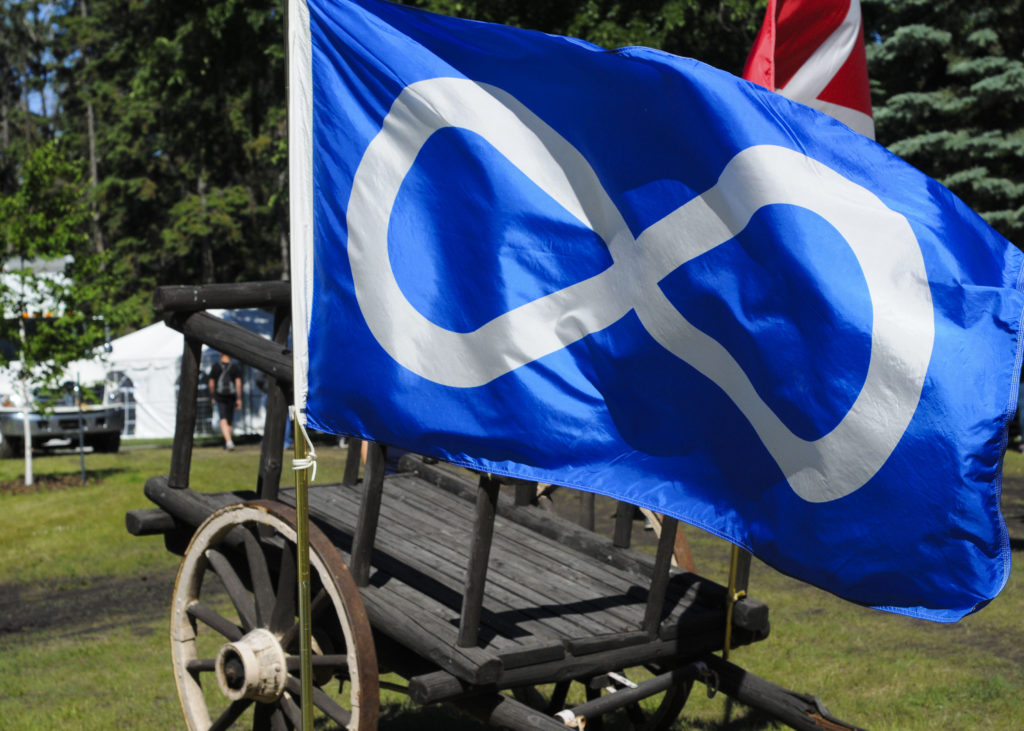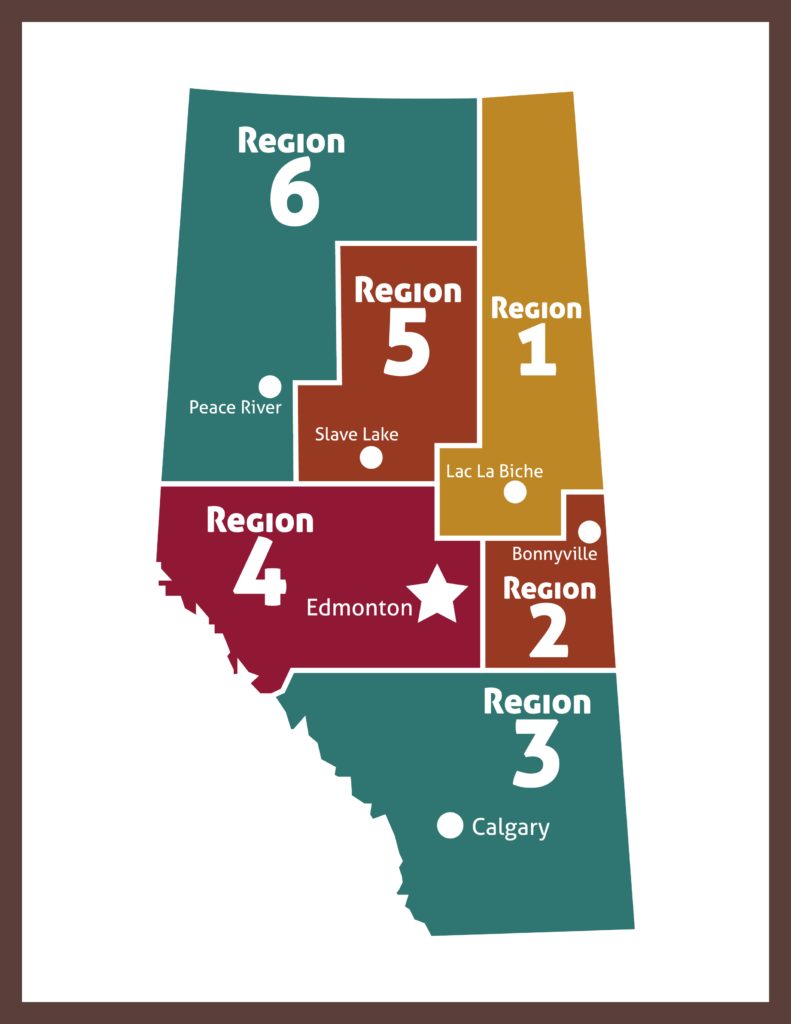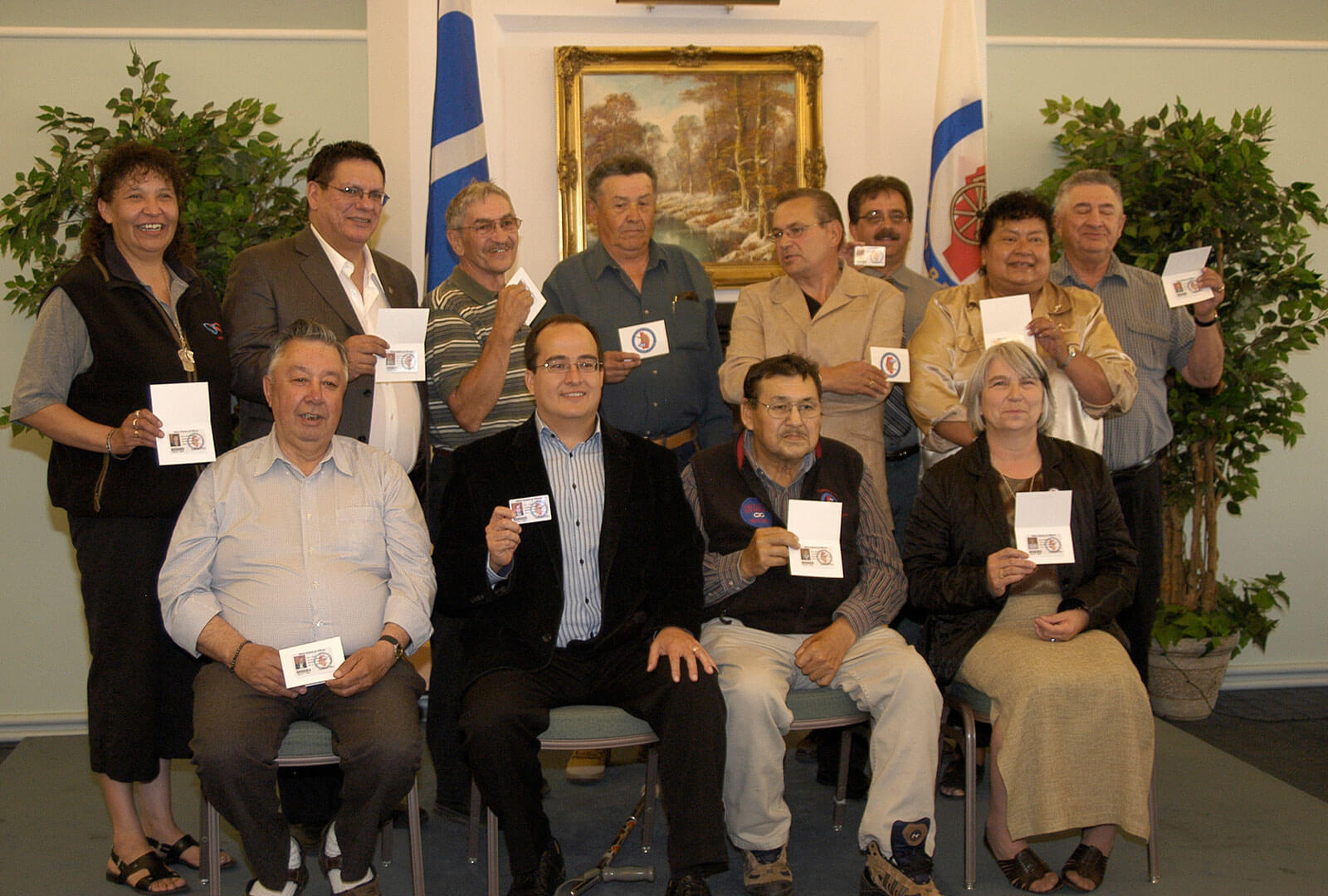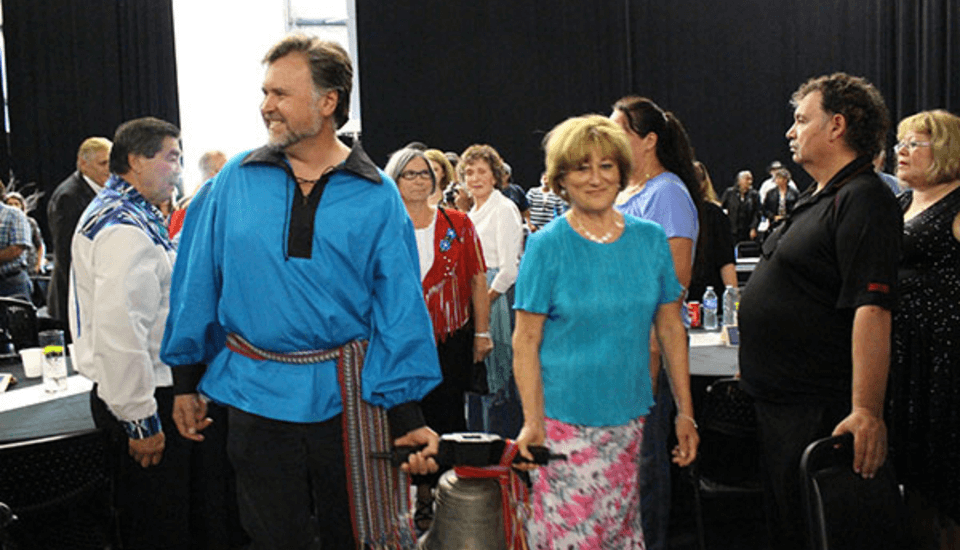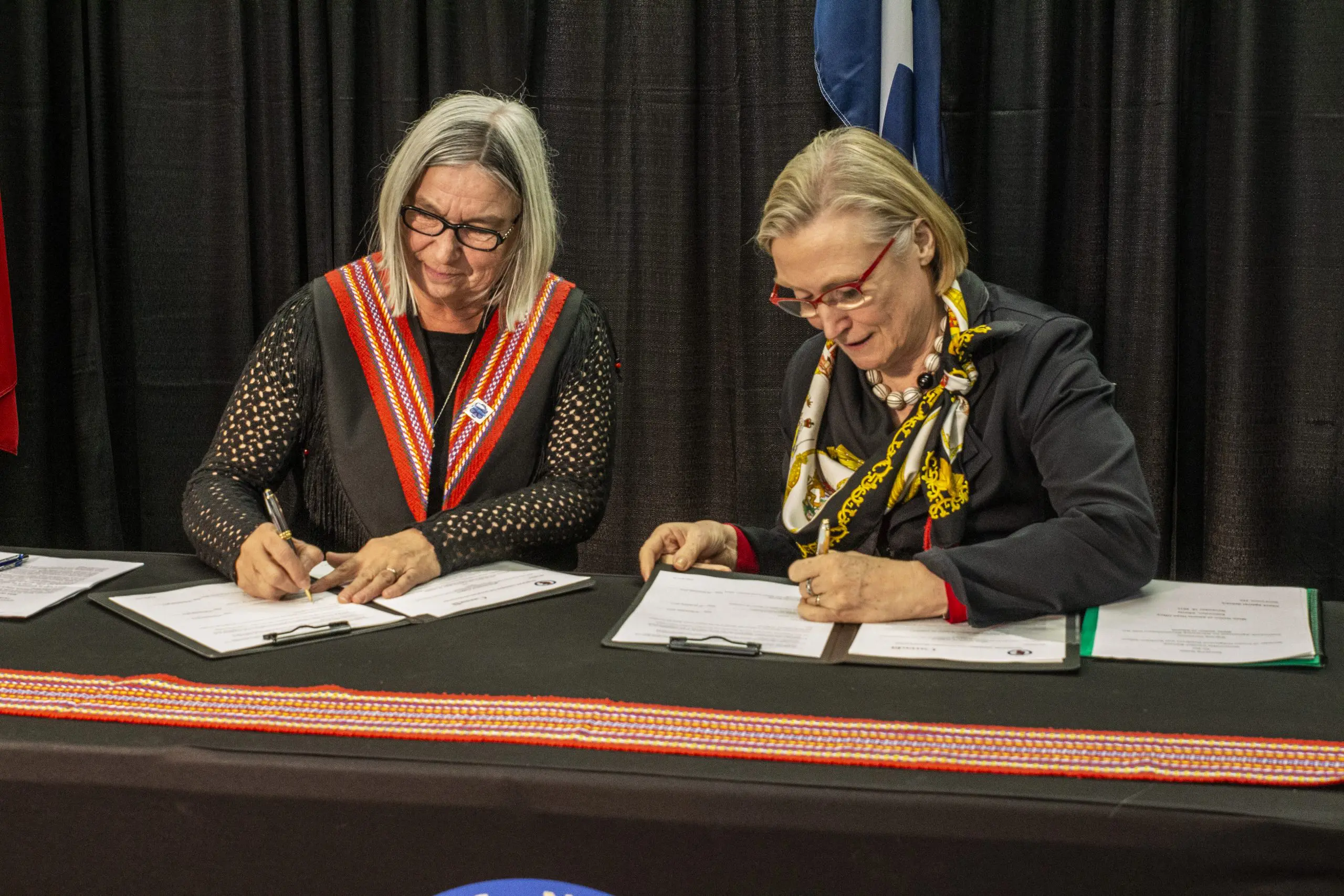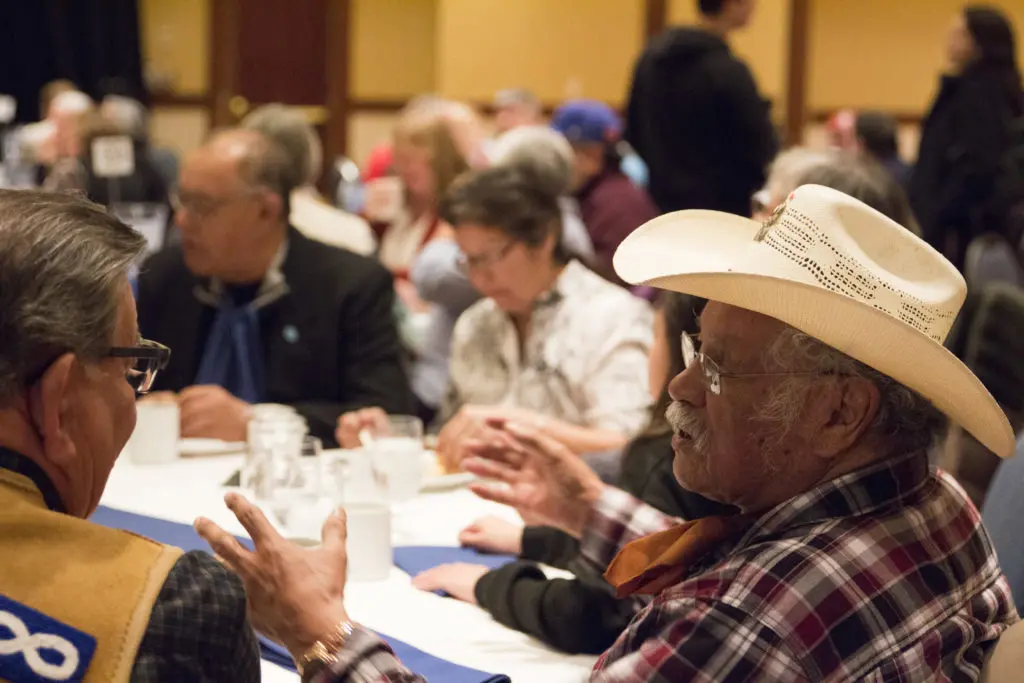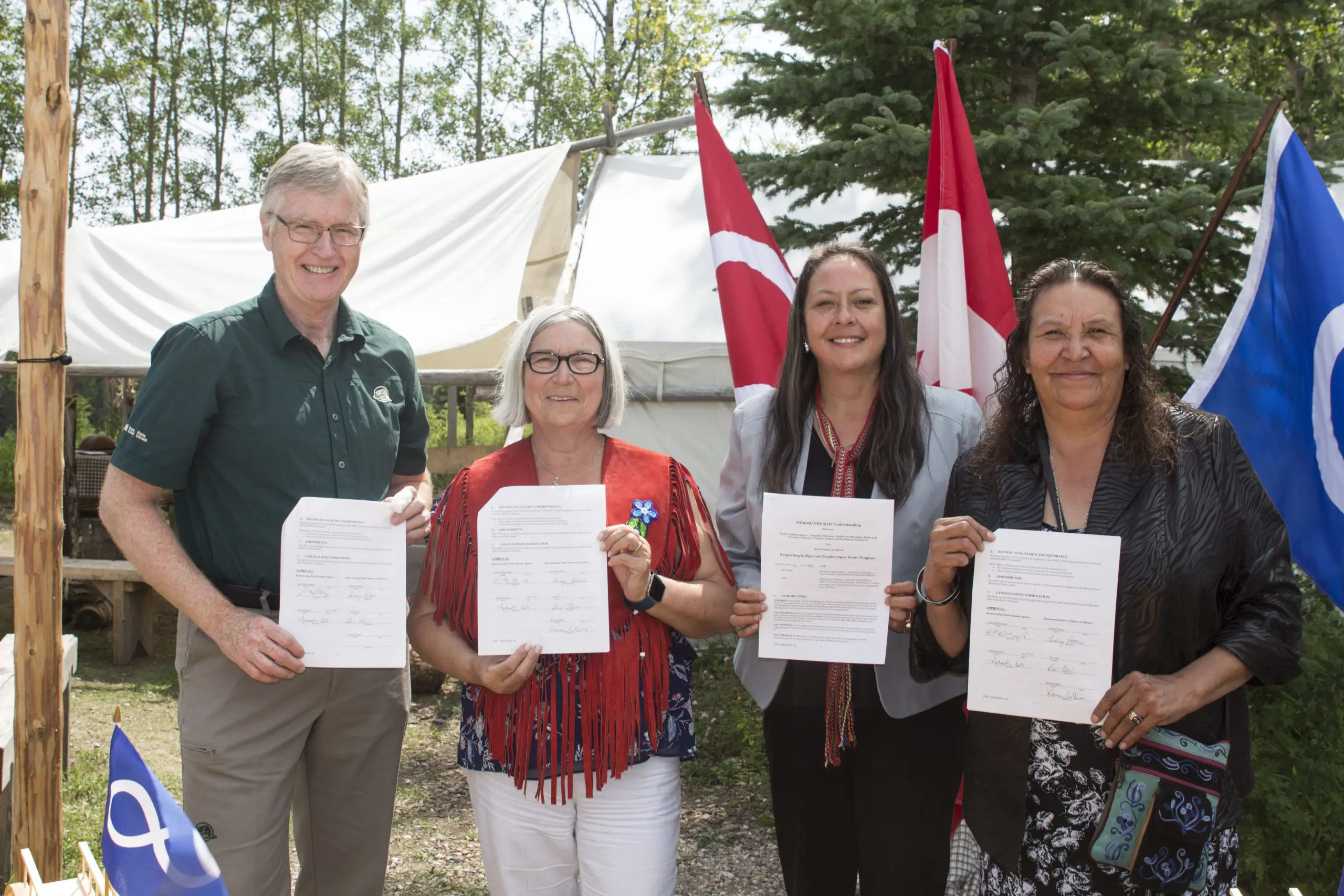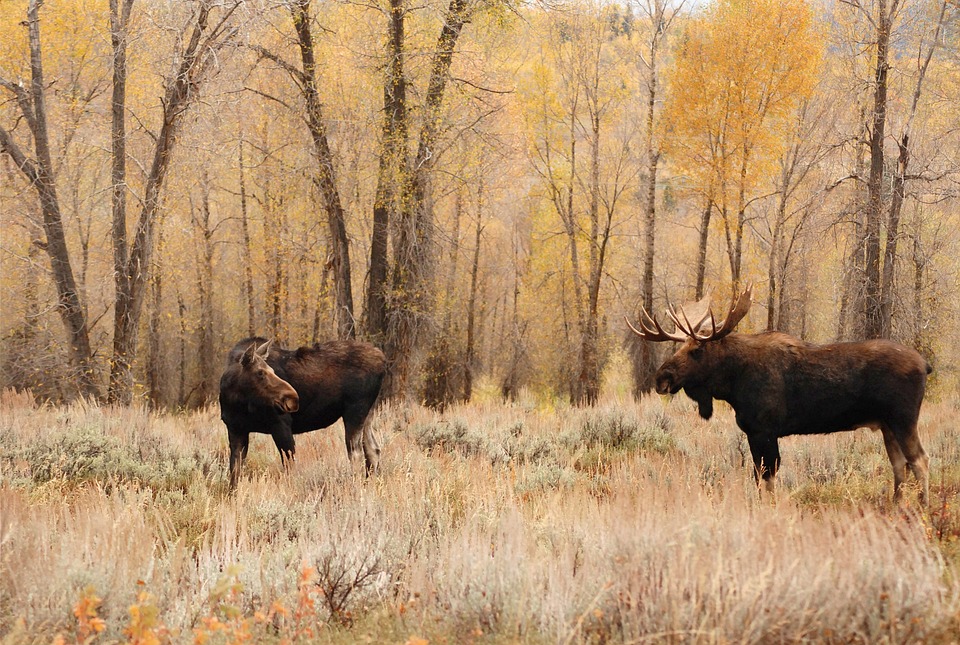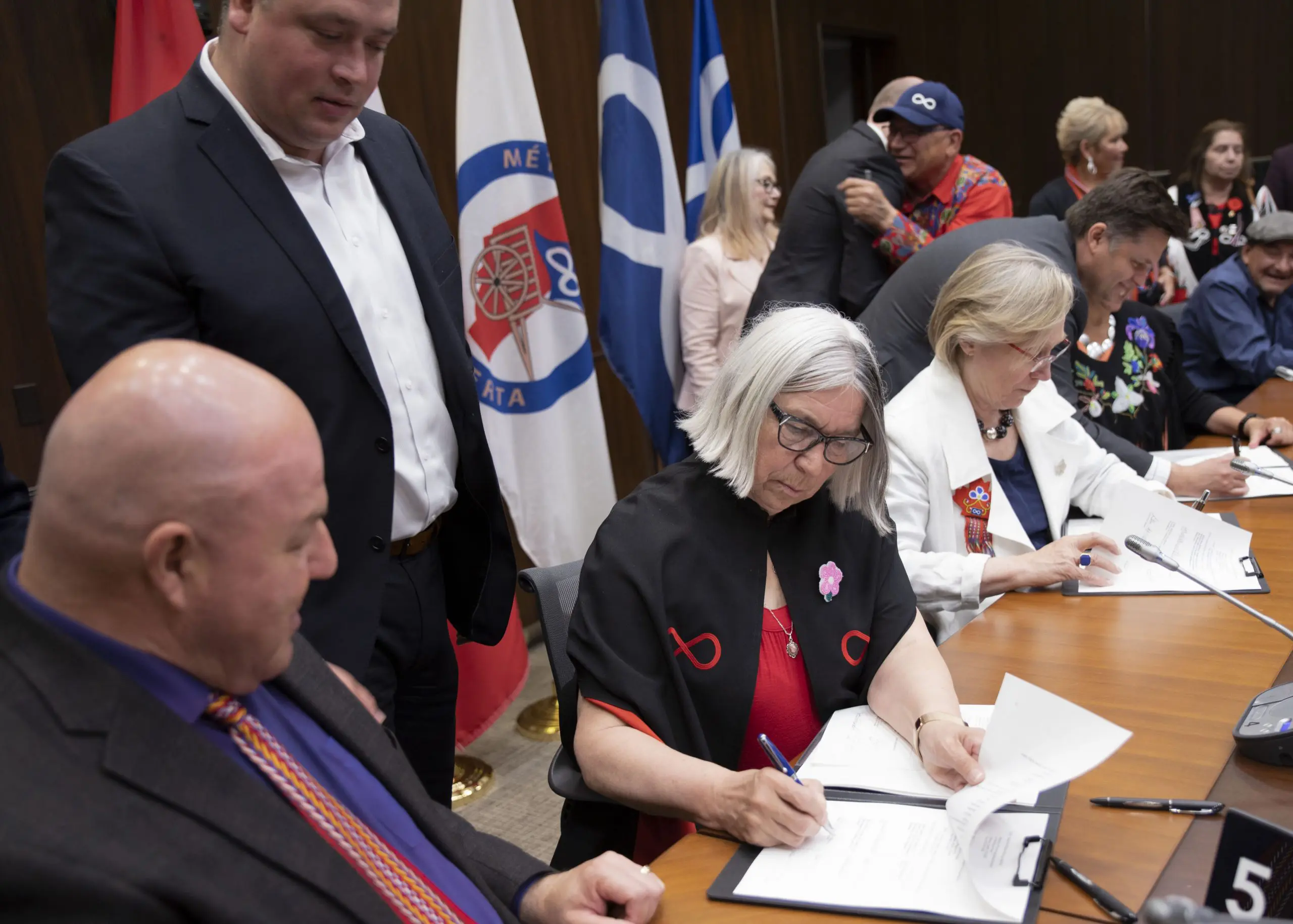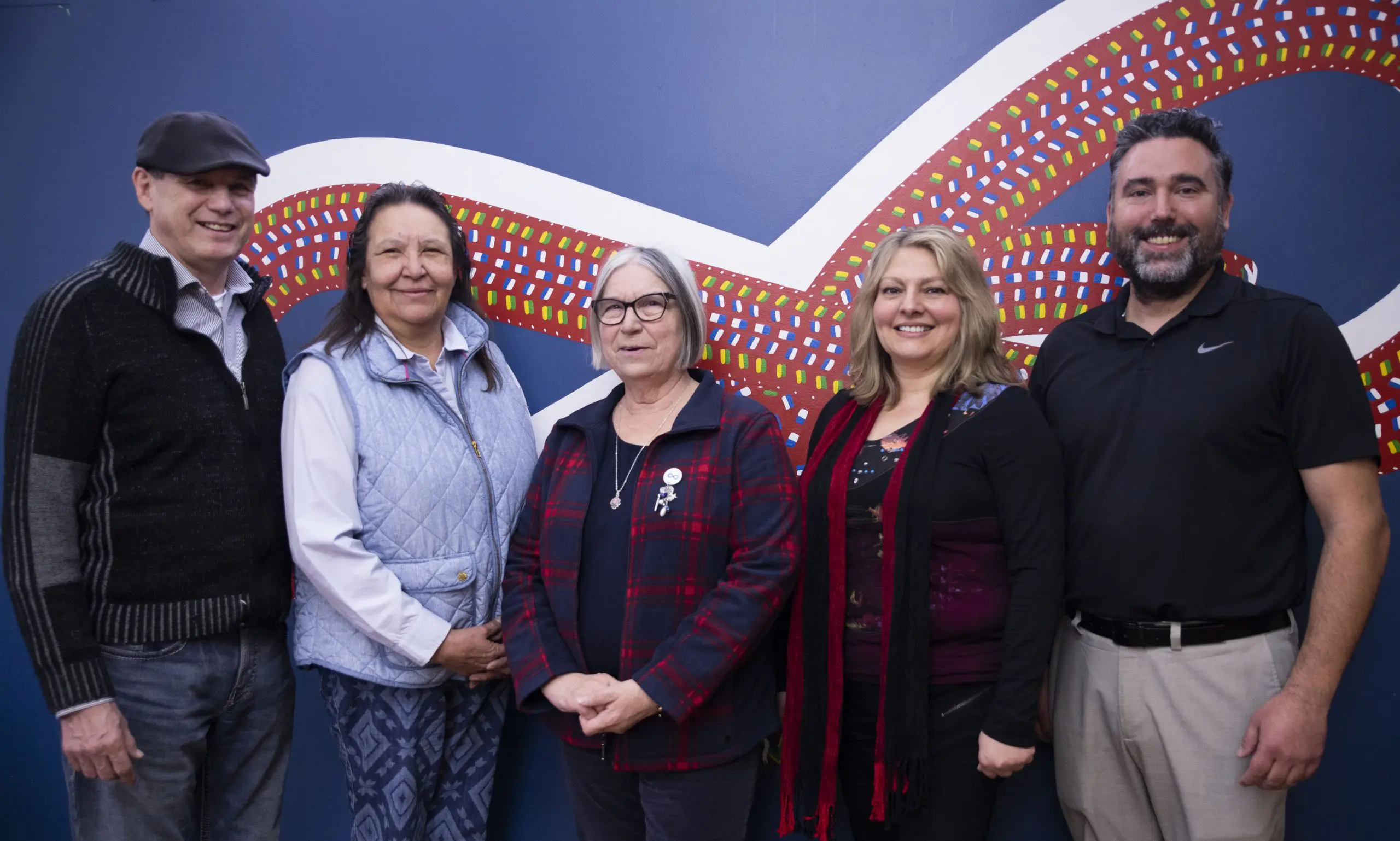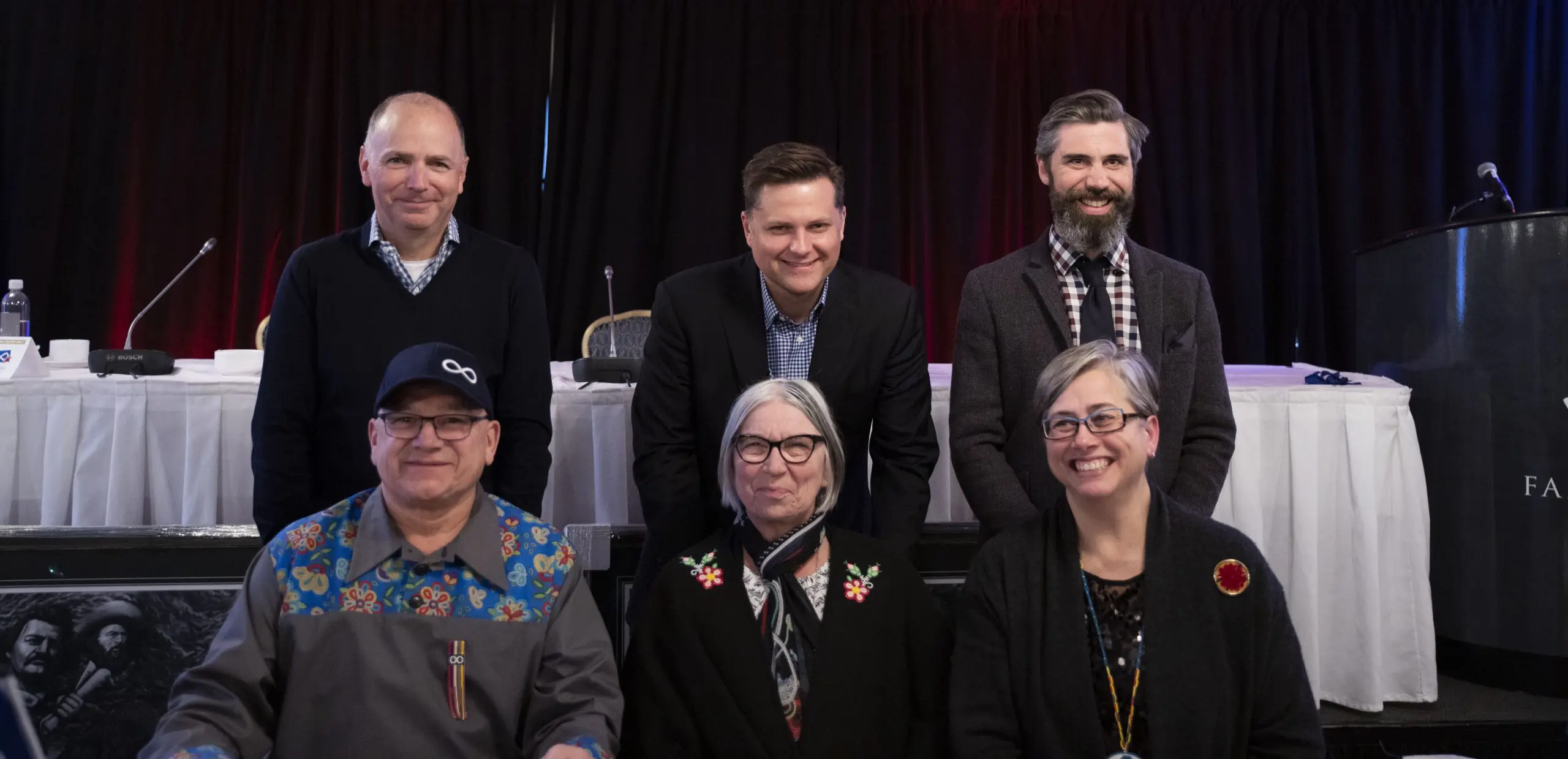1760–1870
Fur Trade
Direct trade between Indigenous people and Europeans begins in present-day Alberta in the 1770s, on the shores of Lake Athabasca. The Métis are originally a product of the fur trade—we are descendants of early unions between European explorers and fur traders and First Nations women. Within a few generations, the descendants of these unions develop a culture distinct from our European and First Nations forebears. The Métis Nation is born. The Métis Nation Homeland includes all of what is now Alberta.

1814
Métis Nation Flag
In a gift-giving ceremony in 1814, Alexander Macdonnell of the North West Company presents the Métis Nation with a flag. The infinity symbol in the flag’s centre represents the joining of two cultures—Indigenous and European—and the immortality of the new Nation. Over 200 years later, the Métis Nation continues to fly the flag with pride.
1816
The Battle of Frog Plain: The Birth of the Métis Nation
The colonial authorities in the Red River attempt to restrict the trade in pemmican. In response, a group of Métis led by Cuthbert Grant capture Fort Brandon, a Hudson’s Bay Company post. It’s a victory to the Métis that cements our status as an independent nation. Known to Canadians as the Battle of Seven Oaks, the Métis remember it as the Battle of Frog Plain.
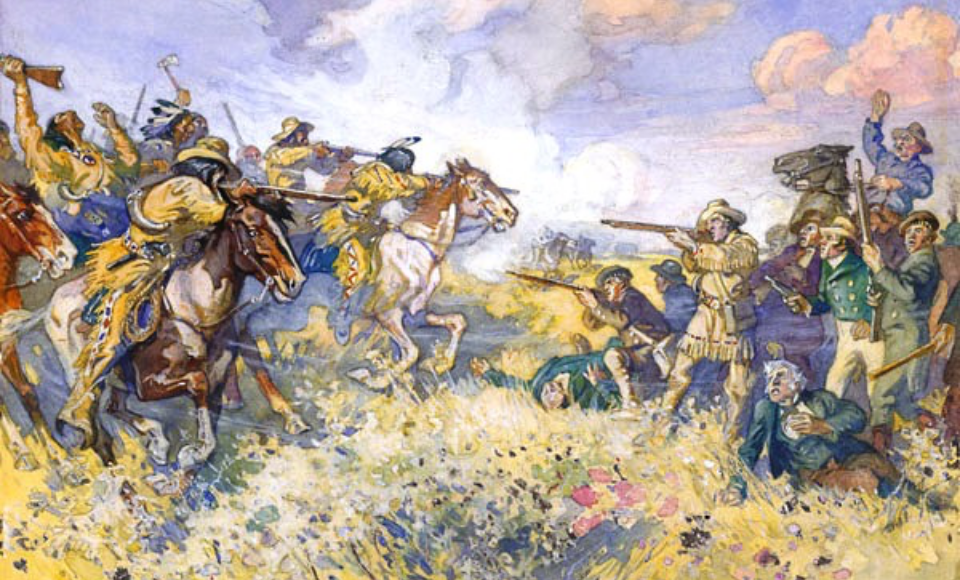
1849
The Sayer Trial: "Le commerce est libre!"
Pierre-Guillaume Sayer, a Métis man, is charged with illegally trading furs in Rupert’s Land. During his trial, a large group of Métis surround the courthouse. Though Sayer is convicted, he is not punished. The assembled crowd celebrates, chanting a rallying cry, “le commerce est libre!” The Hudson’s Bay Company effectively loses the ability to use the courts to enforce its supposed trade monopoly.
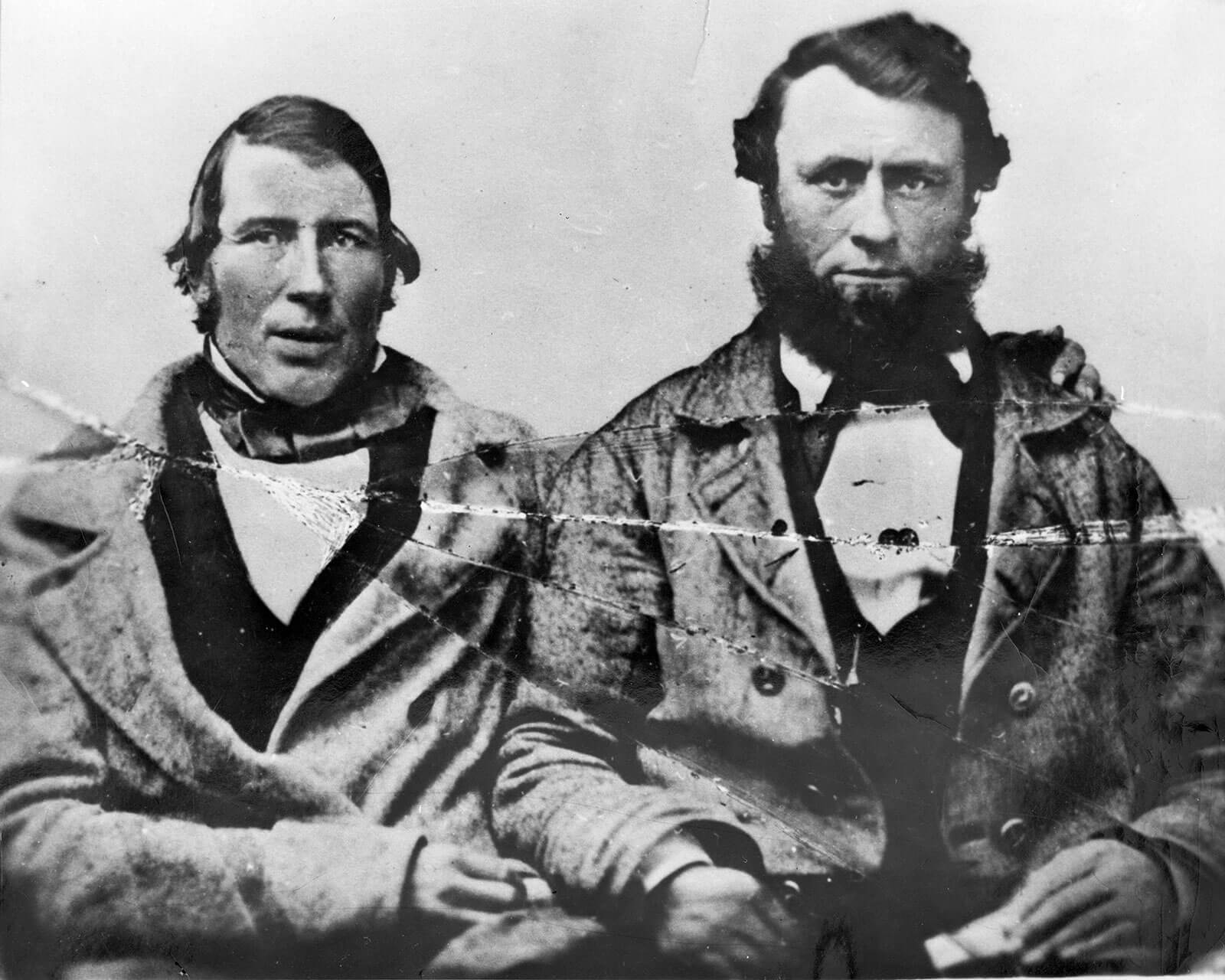
1869–1870
Canada Expands in the Métis Nation Homeland
The Hudson’s Bay Company transfers Rupert’s Land and the Northwestern Territory—which include present-day Alberta—to the newly created Dominion of Canada. Concerned that Canada will not respect their rights and freedoms, the Métis resist. Under the leadership of Louis Riel, the Métis establish our own provisional government in the Red River. The Métis negotiate a treaty with Canada, parts of which become enshrined in the Manitoba Act, 1870. The province of Manitoba is created. The Métis are promised, among other things, 1.4 million acres of land for their children. The Crown fails to fulfill this promise honorably.

1870–85
The Métis Nation Petitions for its Rights
Following the incorporation of the Northwest Territories into Canada, dozens of petitions are sent to the federal government asking that Métis land rights in the territory be formally recognized. Canada’s responses are non-committal. Métis want title to our lands to be formally recognized so that we are not disposed by newly arriving Euro-Canadian settlers, as happened in Manitoba following the Red River Resistance.
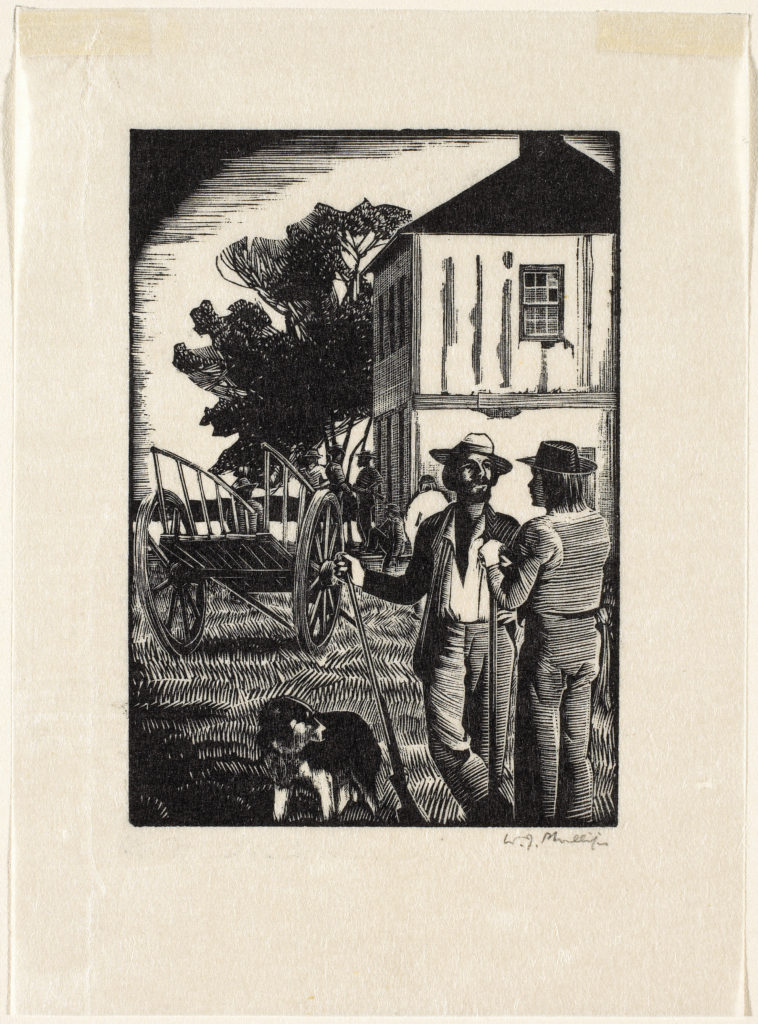
1885
Northwest Resistance
In the face of Canada’s failure to fulfil its promises to the Métis or to respect our rights, the Métis establish the Provisional Government of Saskatchewan, under the leadership of Louis Riel and Gabriel Dumont. Canada crushes the Métis government in what is remembered as the Battle of Batoche. Louis Riel is captured and later executed.

1885–1908
Scrip
Beginning in 1885, Canada offers scrip (a certificate traded for land or money to purchase land) to Métis residing in the Northwest Territories, including present-day Alberta. The scrip system was rife with fraud and abuse. The bulk of scrip ends up in the hands of land speculators; the Métis receive next to nothing for it. The Supreme Court of Canada has said that “the history of scrip speculation and devaluation is a sorry chapter in our nation’s history.”

1896–1909
St. Paul des Métis
In 1896, Father Lacombe, with the backing of the federal government, establishes a reserve and school for Métis who were left destitute after taking scrip. Within little more than a decade, however, the school is closed, the lands are taken over by French Canadian settlers, and the Métis are forced to relocate.

1897
St. Albert Métis Association
Métis in present-day Alberta establish the St. Albert Métis Association. It is formally organized, has an elected president, and conducts meetings using parliamentary procedure. The Association advocates for the fair handling of Métis land claims and petitions Ottawa for improvements to the scrip system.

1921
Criminal Code Amended to Prohibit Prosecution of Métis Scrip Fraud
Alberta Métis seek justice in the courts, pursuing a case for fraud in relation to Métis scrip against a prominent Alberta land speculator, Richard Secord. Senator James Lougheed, grandfather of Premier Peter Lougheed, argues that “there were a good many irregularities amounting to fraud and perjury in connection with the location” of lands that were supposed to have been issued to the Métis under the scrip system, but that the Criminal Code should be amended so scrip fraud cannot be prosecuted. The amendment passes. The Métis are left without legal recourse to challenge scrip fraud.

1928
Association des Métis Alberta et les Territoires du Nord-Ouest
Led by Charles Delorme, Métis in the Cold Lake area organize in response to the federal government’s decision to transfer control of natural resources to the province. They are concerned about the impact of the transfer on Métis living on Crown land. They form the Association des Métis Alberta et les Territoires du Nord-Ouest.
1932
The Métis Association of Alberta
In 1932, the Association des Métis Alberta et les Territoires du Nord-Ouest is organized more formally and becomes the Métis Association of Alberta (MAA), including 31 locals across Alberta. Joe Dion was its first president, with Malcolm Norris, Felix Callihoo, and Pete Tomkins serving as vice-presidents, and James Brady as Secretary Treasurer. They advocate to alleviate Métis poverty and create a secure Métis land base in Alberta.
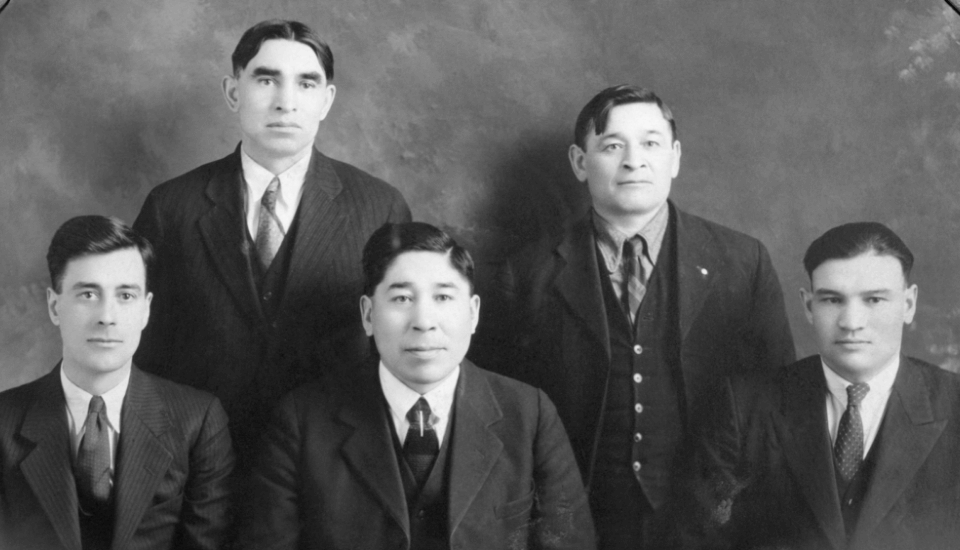
1934
The Ewing Commission
In response to MAA lobbying, Alberta appoints the Half-breed Commission to examine and report on Métis health, education, homelessness, and land issues. Judge Albert F. Ewing is appointed chairman, and the commission becomes known as the Ewing Commission. Joe Dion, Malcom Norris, and Adrian Hope consistently attend the Commission’s hearings on behalf of the MAA. After a two-year investigation, the Commission recommends the province provide Métis with a secure land base and adequate services.

1938
Métis Population Betterment Act
Responding to pressure from the MAA and the Ewing Commission’s recommendations, Alberta adopts the Métis Population Betterment Act, creating the province’s 12 original Métis colonies (known as Métis Settlements).

1939–1945
Métis Serve in the Second World War
Métis serve in the Second World War, fighting for Canada. While overseas, they experience being treated as equals and are exposed to emerging international concepts of human rights and self-determination.

James Brady, founding member of the Métis Association of Alberta, while serving with the Canadian Armed Forces in Holland (1944). Glenbow Archives NA-3517-3.
1960s
Indigenous Mobilization
In keeping with an international trend towards decolonization and self-determination after the Second World War, Indigenous people across North America mobilize in defense of their rights. In Canada, the Métis Nation is at the forefront of this movement.

1961
Métis Association of Alberta is Formally Registered
Under the leadership of Adrian Hope, the MAA formally registers as an association under provincial legislation, giving the MAA access to federal funding. The organization is revitalized. Membership is open to any “Metis, non-treaty Indian, or any person of mixed White and Indian blood.”

1972
The Métis Association of Alberta’s Regions are Created
1982
Constitution Act, 1982
After intense consultations with the MAA, Alberta Premier Peter Lougheed proposes the final wording for what becomes section 35(1) of the Constitution Act, 1982: “The existing aboriginal and treaty rights of the aboriginal peoples of Canada are hereby recognized and affirmed.” “Aboriginal peoples of Canada” is defined to explicitly include the Métis.
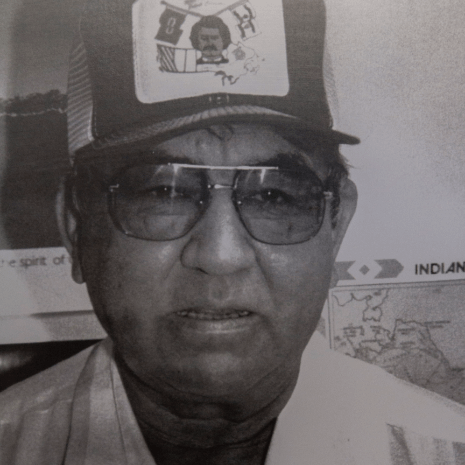
1984
MAA Establishes Regional Offices
Regional offices are established in each of the MAA’s six Regions, significantly increasing the MAA’s capacity to serve our citizens across Alberta.
1985
MAA Membership Restricted to Métis
In response to the inclusion of “Métis” as an Aboriginal people with s. 35 rights, the MAA restricts our membership to Métis persons, excluding non-status Indians.
1987
MAA-Alberta Framework Agreement
The Province of Alberta and the MAA sign our first framework agreement. The MAA becomes the only Métis government in Canada to have a framework agreement with a provincial government. The framework agreement provides the MAA with stable, predictable funding to pursue the priorities of the Métis Nation within Alberta.
1991
The Métis Nation of Alberta
The MAA changes its name, officially becoming the Métis Nation of Alberta Association (MNA). The name change is an clear assertion of Métis nationhood. It also plainly signals the kind of relationship the we intend to have with the federal and provincial governments: nation-to-nation, government-to-government.
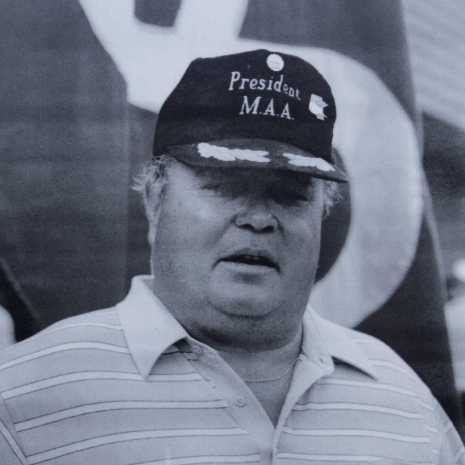
2003
MNA Adopts National Definition of Métis for Citizenship
August 23, 2003 – The MNA Annual Assembly formally adopts the National Definition of Métis for Citizenship within the Métis Nation into our Bylaws. We begin the process of re-registering all our citizens. This work ensures that all MNA citizens are rights-bearing Métis individuals.
2003
R. v. Powley
September 19, 2003 – The Supreme Court of Canada confirms that s. 35 of the Constitution Act, 1982 protects Métis rights. The Court urges Métis groups to standardize their registration systems to identify Métis rights-holders in an objectively verifiable manner.
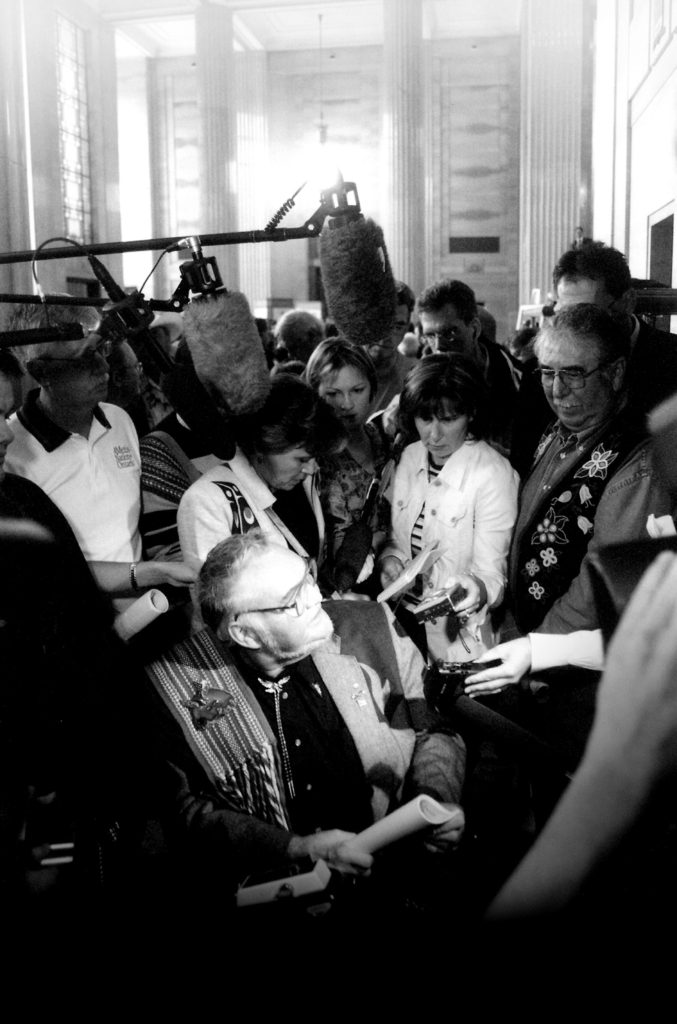
2004
Interim Métis Harvesting Agreement
Alberta and the MNA sign the Interim Métis Harvesting Agreement, which allows MNA citizens to harvest throughout the province.
2006
New MNA Membership Cards
2007
Alberta Cancels Interim Métis Harvesting Agreement
July 2007 – Alberta cancels the Métis Interim Harvesting Agreement and unilaterally imposes a new provincial policy on Métis harvesting in Alberta.
2007
MNA Assembly Adopts Métis Harvesting Rights Action Plan
August 2007 – The MNA Annual Assembly rejects Alberta’s unilateral Métis harvesting policy and adopts a four-part Métis harvesting rights action plan: 1) to exercise the Métis Nation’s rights by organizing hunts; 2) to defend Métis rights by challenging charges brought against Métis harvesters in court; 3) to undertake political action; 4) to educate the public. We called this our hunt for justice.
2007–2013
R. v. Hirsekorn
Garry Hirsekorn is charged under Alberta’s Wildlife Act for shooting a mule deer in the Cypress Hills. The Provincial Court of Alberta convicts Mr. Hirsekorn, holding that there was no historic Métis community in the Cypress Hills and, as a result, there are no current Métis hunting rights in that part of the province. The court recognizes a historic Métis community in central Alberta. Ultimately, this decision is upheld on appeal.
2011
Alberta v Cunningham
2013
Manitoba Métis Federation v Canada
March 8, 2013 – The Supreme Court of Canada confirms the Manitoba Métis community has an outstanding collective claim against the federal government flowing from the promise of 1.4 million acres of land in s. 31 of the Manitoba Act, 1870. The Court also recognizes the Manitoba Métis Federation’s standing to advance this claim based on the authorization it receives from its citizens. This decision sets the stage for a possible Métis claim relating to scrip in Alberta.
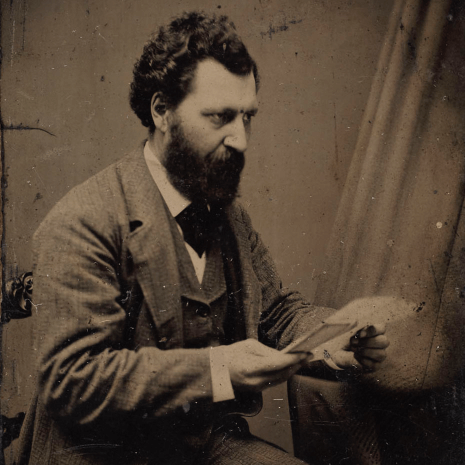
2013
MNA Red & White Cards Cancelled
2015
Eyford Report
February 20, 2015 – Douglas Eyford, Ministerial Special Representative on Renewing the Comprehensive Claims Policy, recommends that “Canada should develop a reconciliation process to support the exercise of Métis section 35(1) rights and to reconcile their interests.”
2016
Daniels v. Canada
April 14, 2016 – The Supreme Court of Canada confirms that the federal government is responsible for dealing with Métis issues. Read the Daniels Decision.

2016
Isaac Report
July 14, 2016 – Thomas Isaac, Ministerial Special Representative on Métis s. 35 Rights, finds that Métis governments, having received expressed legal authorization from Métis s. 35 rights holders, “have the ability to govern in respect of their unique Métis heritage and Section 35 rights.” Isaac recommends Canada develop a policy “that expressly addresses Métis Section 35 rights claims and related issues.”
2016
New Objective: Negotiating a Modern-Day Treaty
August 7, 2016 – The MNA Annual Assembly amends our bylaws to include negotiating a modern-day treaty on behalf of Métis in Alberta as one of our objectives and to adopt a new Oath of Membership. The new Oath provides clarifies our mandate to advance Métis rights and claims on behalf of Métis in Alberta.
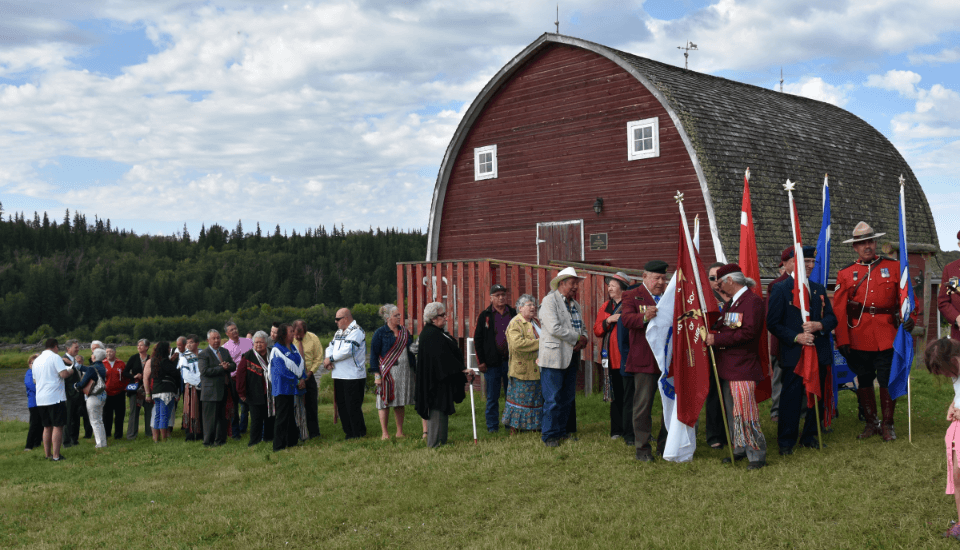
2017
MNA-Canada MOU on Advancing Reconciliation
January 30, 2017 – Canada and the MNA sign the Memorandum of Understanding on Advancing Reconciliation (MOU), putting us on track to negotiate a modern-day treaty for Métis in Alberta. In part because of our new objective and Oath of Membership, the MOU acknowledges that “the MNA is mandated to advance Métis rights, self-government and self-determination in Alberta.”
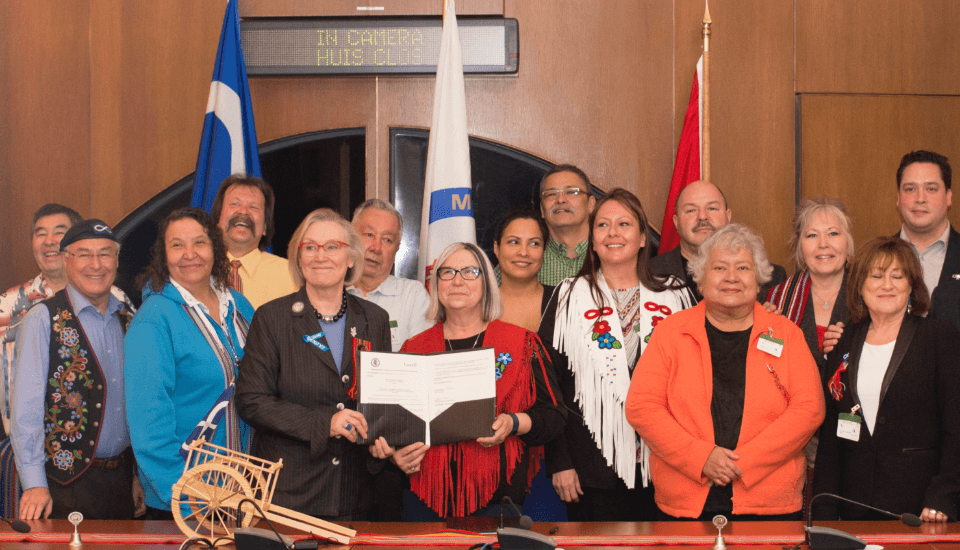
2017
MNA-Alberta Framework Agreement
February 1, 2017 – Alberta and the MNA sign a renewed 10-year Framework Agreement, in which Alberta “recognizes the MNA’s representative role on behalf of its Citizens.” The Framework Agreement includes commitments to deal with Métis harvesting, consultation, and other rights-related issues.

2017
Canada-Métis Nation Accord
April 13, 2017 – Canada and the Métis National Council and its governing members, including the MNA, sign the Canada-Métis Nation Accord. The Accord confirms that the Métis National Council’s governing members are mandated and authorized to represent the Métis Nation’s citizens to deal with collectively held Métis rights and claims against the Crown.
Prime Minister Justin Trudeau and MNA President Audrey Poitras at the Canada-Métis Accord signing (November 16, 2017)Canada-Métis Nation Accord
2017
MNA-Canada Framework Agreement on Advancing Reconciliation
November 16, 2017 – Canada and the MNA sign the Framework Agreement on Advancing Reconciliation. This marks the beginning of formal negotiations recognizing Métis rights, resolving long-standing grievances (such as those relating to the scrip system), and establishing modern self-government for the Métis Nation within Alberta.
2018
Initial Constitution Engagements
2018
Skills and Employment Training Sub-Accord
June 15, 2018 – Métis National Council and Canada sign the Métis Nation Skills and Employment Accord, which provides a framework to jointly implement the Métis National Labour Market Strategy. The strategy focuses on enhanced employment services, skills development, and job training to improve the overall well-being of the Métis Nation. The signing follows a $625 million commitment over 10 years from Canada for the Métis Nation stream of the Indigenous Skills and Employment Training Program.
2018
Métis National Housing Sub-Accord
July 19, 2018 – Métis National Council and Canada sign the Métis National Housing Accord. The accord outlines Canada’s commitment of $500 million over ten years to support the implementation of a Métis Nation Housing Strategy. As a result, in October 2019, our housing branch, Métis Capital Housing Corporation, launches four new housing programs to support Métis families and students including rental supports, home repairs, and down payment assistance.
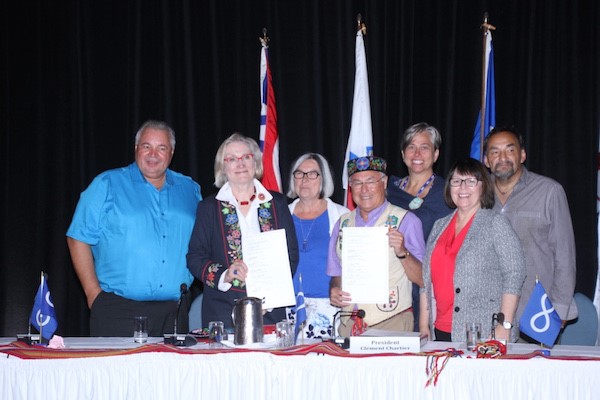
2018
Indigenous Peoples Open Doors Program
2019
MNA-Alberta Métis Harvesting Agreement
March 12, 2019 – The MNA and Alberta government sign the Métis Harvesting Agreement. This agreement enables the implementation of the Métis Harvesting in Alberta Policy (2018), which replaces a 2010 policy. The new policy and agreement recognize the rights of eligible MNA citizens to hunt, fish, and trap for food in four regional harvesting areas in central and northern Alberta. The agreement also recognizes our authority to issue identification to eligible Métis harvesters and commits Alberta to further discussions about recognizing Métis harvesting rights in southern Alberta.
2019
MNA Signs Historic Self-Government Agreement
June 27, 2019 – After more than 90 years of perseverance and struggle, we sign the Métis Government Recognition and Self-Government Agreement (MGRSA), the first ever self-government agreement between the Government of Canada and a Métis government. The MGRSA explicitly recognizes the Métis Nation within Alberta as having an inherent and constitutionally protected right to self-government. It also creates a process for us to be recognized as an Indigenous government in federal legislation.
2019
Constitution Commission Formed
December 2019 – Following an application process, the Métis Nation of Alberta Constitution Commission is created. This panel of five MNA citizens is tasked with drafting an MNA Constitution based on past and present citizen feedback, engaging with citizens on the draft Constitution, and overseeing the ratification process of the Constitution and the MGRSA.
2020
Tri-council Meeting
January 14-16, 2020 – The Métis governments of Alberta, Ontario, and Saskatchewan hold a Métis government meeting, marking the first gathering of elected representatives from the MNA, Métis Nation of Ontario (MNO), and Métis Nation-Saskatchewan (MN-S) since each signed their own Métis Government Recognition and Self-Government Agreement (MGRSA) with the federal government.
At the meeting, the three governments discuss how they can collaborate to advance their visions of Métis Nation self-government in their respective provinces. The three governments also call for more transparency and accountability of the Métis National Council (MNC).
2020
Otipemisiwak: A National Conference on Métis Self-Government
March 9-10, 2020 – The Métis Nation of Ontario (MNO) hosts the MNA and Métis Nation-Saskatchewan (MN-S) in Gatineau, Quebec for the first-ever conference on Métis self-government. Métis citizens from British Columbia, Alberta, Saskatchewan, and Ontario attended the conference to learn and discuss Métis history, the trials and triumphs of self-governance, and the strides made in recent years.
